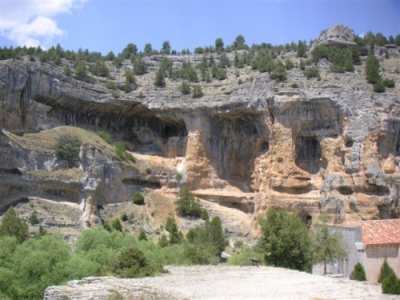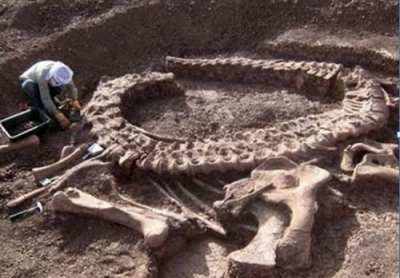Las Hoyas
Cuenca province is home to one of the most important archaeological sites of the early Cretaceous period, Las Hoyas, the fossilised remains of a complete ecosystem from 125 million years ago, when dinosaurs still roamed the Earth.
Twenty five years of investigation have excavated fossils of all types of organisms which lived in this Mesozoic habitat. It was a tropical climate with mild temperatures where there were once freshwater lakes and marshland. Scientists from the Universidad Autónoma de Madrid and the Universidad Complutense describe it as the first modern marshland in the planet’s history and one of the oldest and best preserved fossilised ecosystems in the world.

Photo - fotopaises.com
It was discovered in the Serranía de Cuenca 25 years ago and has given up extraordinary evidence of the reptiles, fish, insects, birds, plants, algae and micro-organisms from the Earth’s past.
The species found are exceptionally well preserved, and have been key in revealing the link between the dinosaurs and the birds of today. It was here that Concavenator corcovatus was found, the ‘hunch-backed hunter from Cuenca’, a two-legged carnivorous theropod dinosaur with quill-like structures on its forearms, seen to be an ancestral stage of the feathers of modern birds.

Photo - absolutcuenca.com
It is the most complete articulated skeleton which has ever been found in Spain.
But the larger beasts did not inhabit Las Hoyas and would only visit the marshlands as they passed through.
Las Hoyas is from the period when the first birds, mammals, and reptiles such as the crocodile and lizards, flowering plants and fish began to diversify. Jesús Marugán from the research team at Las Hoyas describes it as, ‘The moment when the splendour of life on the planet as we know it today began to hatch’.
But what is considered much more valuable than each of the individual finds made here is, as chief researcher at Las Hoyas, Ángela D. Buscialioni, Professor of Palaeontology at UAM, says, ‘is the possibility to reconstruct with unprecedented detail the complete puzzle of a Mesozoic ecosystem.’
The past decade’s work in the second phase of investigations at the site has now concluded. Scientists have discovered an amazingly diverse array of species: crustaceans and insects, aquatic plants, flowering plants, salamanders, lizards, amphibians, dwarf crocodiles, an abundance of enantiornithes – primitive birds with teeth and clawed hands.
Freshwater crabs found here are almost indistinguishable from those which inhabit our rivers and lakes today, and although many species of primitive fish have been found, there is also a variety of modern teleosts, the group to which most living fish today belong.
The skies were dominated by pterosaurs, a group of flying reptiles which left no descendants. The oldest fossilised example of a toothless pterosaur yet discovered was found in Las Hoyas.
But even the smallest of organisms have been remarkably significant in these 25 years of investigations. Scientists at the UAM have concluded that bacteria were responsible for the extraordinary level of preservation in this place. Their studies have shown that the entire ecosystem would have been covered in a microbial mantle of algae and bacteria which, by enveloping the bodies of the creatures which died, would have slowed their decomposition.
